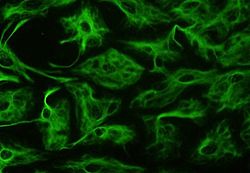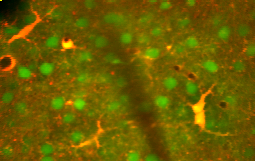User:Graypath/Sandbox
| Graypath/Sandbox | |
|---|---|
 Astrocytes can be visualized in culture because, unlike other mature glia, they express glial fibrillary acidic protein. | |
| Details | |
| Precursor | Glioblast |
| Anatomical terminology | |
Astrocytes (also known collectively as astroglia) are characteristic star-shaped glial cells in the brain. They perform many functions, including biochemical support of endothelial cells which form the blood-brain barrier, the provision of nutrients to the nervous tissue, and a principal role in the repair and scarring process in the brain.
Description
[edit]Astrocytes are a sub-type of the glial cells in the brain. They are also known as astrocytic glial cells. Star-shaped, their many processes envelope synapses made by neurons. Astrocytes are classically identified histologically as many of these cells express the intermediate filament glial fibrillary acidic protein (GFAP). Two forms of astrocytes exist in the CNS, fibrous and protoplasmic. The former is usually located within white matter, have relatively few organelles, and exhibit long unbranched organelles. This type often have "vascular feet" that physically connect the cells to the outside of capillary wall when they are in close proximity of them. The latter, found in grey matter tissue, possess a larger quantity of organelles, and exhibit short and highly branched cellular processes. The two forms of astrocytes when in proximity to the pia mater sends out process to form the pia-glial membrane.

Previously in medical science, the neuronal network was considered the only important one, and astrocytes were looked upon as gap fillers. But recently they have been reconsidered, and are now thought to play a number of active roles in the brain, including the secretion or absorption of neural transmitters and maintenance of the blood-brain barrier.
Functions
[edit]- Structural: involved in the physical structuring of the brain.
- Metabolic support: they provide neurons with nutrients such as glucose.
- Blood-brain barrier: the astrocyte end-feet encircling endothelial cells were thought to aid in the maintenance of the blood-brain barrier, but recent research indicates that they do not play a substantial role, instead it is the tight junctions and basal lamina of the cerebral endothelial cells that play the most substantial role in maintaining the barrier.[citation needed]
- Transmitter reuptake and release: astrocytes express plasma membrane transporters such as glutamate transporters for several neurotransmitters, including glutamate, ATP and GABA. More recently, astrocytes were shown to release glutamate or ATP in a vesicular, Ca2+-dependent manner.[citation needed]
- Regulation of ion concentration in the extracellular space: astrocytes express potassium channels at a high density. When neurons are active, they release potassium, increasing the local extracellular concentration. Because astrocytes are highly permeable to potassium, they rapidly clear the excess accumulation in the extracellular space. If this function is interfered with, the extracellular concentration of potassium will rise, leading to neuronal depolarization by the Goldman equation. Abnormal accumulation of extracellular potassium is well known to result in epileptic neuronal activity.[citation needed]
- Modulation of synaptic transmission: in the supraoptic nucleus of the hypothalamus, rapid changes in astrocyte morphology have been shown to affect heterosynaptic transmission between neurons.[1]
- Vasomodulation: astrocytes may serve as intermediaries in neuronal regulation of blood flow.[2]
- Promotion of the myelinating activity of oligodendrocytes: electrical activity in neurons causes them to release ATP, which serves as an important stimulus for myelin to form. Surprisingly, the ATP does not act directly on oligodendrocytes. Instead it causes astrocytes to secrete LIM, a regulatory protein that promotes the myelinating activity of oligodendrocytes. This suggest that astrocytes have an executive-coordinating role in the brain.[3]
- Upon injury to nerve cells within the central nervous system, astrocytes become phagocytic to ingest the injured nerve cells. Afterwards, the astrocytes fill up the space to form a glial scar. This is due to the nature of nerve cells in CNS being incapable of regeneration and glial scar is formed as a form of repair.
Furthermore, studies are underway to determine whether astroglia play an instrumental role in depression, based on the link between diabetes and depression. Altered CNS glucose metabolism is seen in both these conditions, and the astroglial cells are the only cells with insulin receptors in the brain.
Calcium waves
[edit]Astrocytes are linked by gap junctions, creating an electrically coupled syncytium.[4]
An increase in intracellular calcium concentration can propagate outwards through this syncytium. Mechanisms of calcium wave propagation include diffusion of IP3 through gap junctions and extracellular ATP signalling.[5] Calcium elevations are the primary known axis of activation in astrocytes, and are necessary and sufficient for some types of astrocytic glutamate release.[6]
Classification
[edit]There are several different ways to classify astrocytes:
by Lineage and antigenic phenotype
[edit]These have been established by classic work by Raff et al in early 1980s on Rat optic nerves.
- Type 1: Antigenically Ran2+, GFAP+, FGFR3+, A2B5- thus resembling the "type 1 astrocyte" of the postnatal day 7 rat optic nerve. These can arise from the tripotential glial restricted precursor cells (GRP), but not from the bipotential O2A/OPC (oligodendrocyte, type 2 astrocyte precursor, also called Oligodendrocye progenitor cell) cells.
- Type 2: Antigenically A2B5+, GFAP+, FGFR3-, Ran 2-. These cells can develop in vitro from the either tripotential GRP (probably via O2A stage) or from bipotential O2A cells (which some people think may in turn have been derived from the GRP) or in vivo when the these progenitor cells are transplanted into lesion sites (but probably not in normal development, at least not in the rat optic nerve). Type-2 astrocytes are the major astrocytic component in postnatal optic nerve cultures that are generated by O2A cells grown in the presence of fetal calf serum but are not thought to exist in vivo (Fulton et al., 1992).
by Anatomical Classification
[edit]- Protoplasmic: found in grey matter and have many branching processes whose end-feet envelop synapses. Some protoplasmic astrocytes are generated by multipotent subventricular zone progenitor cells (Levison and Goldman, 1993; Zerlin et al., 1995).
- Fibrous: found in white matter and have long thin unbranched processes whose end-feet envelop nodes of Ranvier[7]and also they play an important on humans brain. Some fibrous astrocytes are generated by radial glia (Choi and Lapham, 1978; Schmechel and Rakic, 1979; Misson et al., 1988; Voigt, 1989; Goldman, 1996
by Transporter/receptor classification
[edit]- GluT type: express glutamate transporters (EAAT1/SLC1A3 and EAAT2/SLC1A2) and respond to synaptic release of glutamate by transporter currents
- GluR type: express glutamate receptors (mostly mGluR and AMPA type) and respond to synaptic release of glutamate by channel-mediated currents and IP3-dependent Ca2+ transients
Bergmann glia
[edit]Bergmann glia, a type of glia[8][9] also known as radial epithelial cells (as named by Camillo Golgi), are astrocytes in the cerebellum that have their cell bodies in the Purkinje cell layer and processes that extend into the molecular layer, terminating with bulbous endfeet at the pial surface. Bergmann glia express high densities of glutamate transporters that limit diffusion of the neurotransmitter glutamate during its release from synaptic terminals. Besides their role in early development of the cerebellum, Bergmann glia are also required for the pruning or addition of synapses.
Pathology
[edit]Astrocytomas are primary intracranial tumors derived from astrocytes cells of the brain.
References
[edit]- ^ Piet R, Vargová L, Syková E, Poulain D, Oliet S (2004). "Physiological contribution of the astrocytic environment of neurons to intersynaptic crosstalk". Proc Natl Acad Sci U S A. 101 (7): 2151–5. doi:10.1073/pnas.0308408100. PMID 14766975.
{{cite journal}}: CS1 maint: multiple names: authors list (link) - ^ Parri R, Crunelli V (2003). "An astrocyte bridge from synapse to blood flow". Nat Neurosci. 6 (1): 5–6. doi:10.1038/nn0103-5. PMID 12494240.
- ^ Ishibashi T, Dakin K, Stevens B, Lee P, Kozlov S, Stewart C, Fields R (2006). "Astrocytes promote myelination in response to electrical impulses". Neuron. 49 (6): 823–32. doi:10.1016/j.neuron.2006.02.006. PMID 16543131.
{{cite journal}}: CS1 maint: multiple names: authors list (link) - ^ Bennett M, Contreras J, Bukauskas F, Sáez J (2003). "New roles for astrocytes: gap junction hemichannels have something to communicate". Trends Neurosci. 26 (11): 610–7. doi:10.1016/j.tins.2003.09.008. PMID 14585601.
{{cite journal}}: CS1 maint: multiple names: authors list (link) - ^ Newman, J Neurosci. 2001 Apr 1;21(7):2215-23
- ^ Parpura V, Haydon P (2000). "Physiological astrocytic calcium levels stimulate glutamate release to modulate adjacent neurons". Proc Natl Acad Sci U S A. 97 (15): 8629–34. doi:10.1073/pnas.97.15.8629. PMID 10900020.
- ^
{{MUNAnatomy|nerve/neuron}} - ^ Riquelme R, Miralles C, De Blas A (2002). "Bergmann glia GABA(A) receptors concentrate on the glial processes that wrap inhibitory synapses". J. Neurosci. 22 (24): 10720–30. PMID 12486165.
{{cite journal}}: CS1 maint: multiple names: authors list (link) - ^ Yamada K, Watanabe M (2002). "Cytodifferentiation of Bergmann glia and its relationship with Purkinje cells". Anatomical science international / Japanese Association of Anatomists. 77 (2): 94–108. PMID 12418089.
